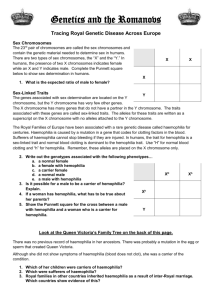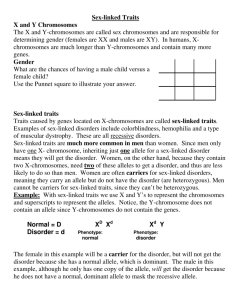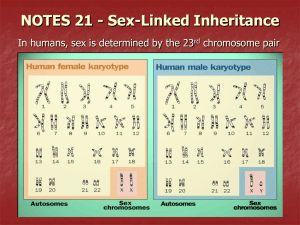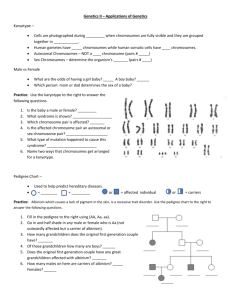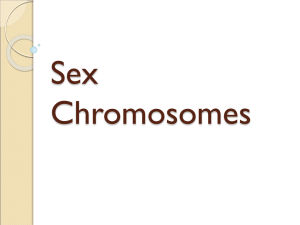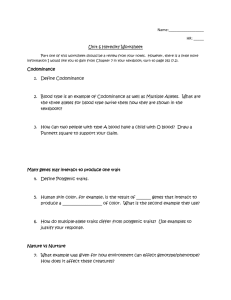3—9 What are sex
advertisement
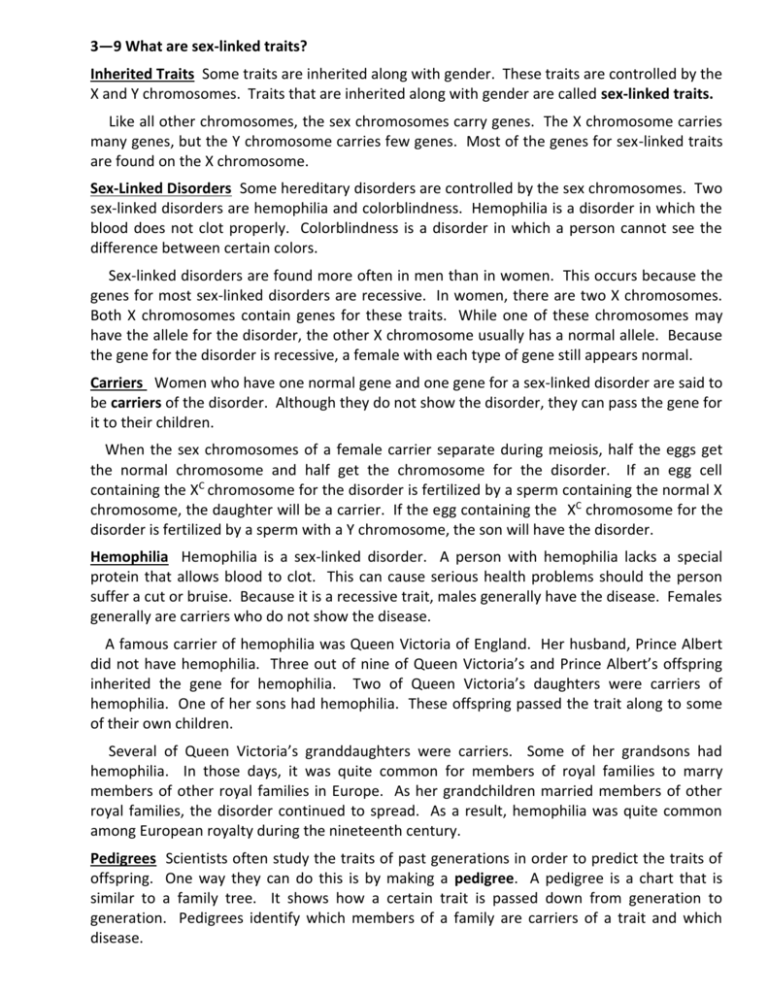
3—9 What are sex-linked traits? Inherited Traits Some traits are inherited along with gender. These traits are controlled by the X and Y chromosomes. Traits that are inherited along with gender are called sex-linked traits. Like all other chromosomes, the sex chromosomes carry genes. The X chromosome carries many genes, but the Y chromosome carries few genes. Most of the genes for sex-linked traits are found on the X chromosome. Sex-Linked Disorders Some hereditary disorders are controlled by the sex chromosomes. Two sex-linked disorders are hemophilia and colorblindness. Hemophilia is a disorder in which the blood does not clot properly. Colorblindness is a disorder in which a person cannot see the difference between certain colors. Sex-linked disorders are found more often in men than in women. This occurs because the genes for most sex-linked disorders are recessive. In women, there are two X chromosomes. Both X chromosomes contain genes for these traits. While one of these chromosomes may have the allele for the disorder, the other X chromosome usually has a normal allele. Because the gene for the disorder is recessive, a female with each type of gene still appears normal. Carriers Women who have one normal gene and one gene for a sex-linked disorder are said to be carriers of the disorder. Although they do not show the disorder, they can pass the gene for it to their children. When the sex chromosomes of a female carrier separate during meiosis, half the eggs get the normal chromosome and half get the chromosome for the disorder. If an egg cell containing the XC chromosome for the disorder is fertilized by a sperm containing the normal X chromosome, the daughter will be a carrier. If the egg containing the XC chromosome for the disorder is fertilized by a sperm with a Y chromosome, the son will have the disorder. Hemophilia Hemophilia is a sex-linked disorder. A person with hemophilia lacks a special protein that allows blood to clot. This can cause serious health problems should the person suffer a cut or bruise. Because it is a recessive trait, males generally have the disease. Females generally are carriers who do not show the disease. A famous carrier of hemophilia was Queen Victoria of England. Her husband, Prince Albert did not have hemophilia. Three out of nine of Queen Victoria’s and Prince Albert’s offspring inherited the gene for hemophilia. Two of Queen Victoria’s daughters were carriers of hemophilia. One of her sons had hemophilia. These offspring passed the trait along to some of their own children. Several of Queen Victoria’s granddaughters were carriers. Some of her grandsons had hemophilia. In those days, it was quite common for members of royal families to marry members of other royal families in Europe. As her grandchildren married members of other royal families, the disorder continued to spread. As a result, hemophilia was quite common among European royalty during the nineteenth century. Pedigrees Scientists often study the traits of past generations in order to predict the traits of offspring. One way they can do this is by making a pedigree. A pedigree is a chart that is similar to a family tree. It shows how a certain trait is passed down from generation to generation. Pedigrees identify which members of a family are carriers of a trait and which disease. CHECKING CONCEPTS 1. Traits that are inherited along with gender are called 2. Most of the genes for sex-linked traits are found on the traits. chromosome. 3. The genes for most sex-linked disorders are . 4. A female who has a gene for a sex-linked disorder but does not show the disorder is a . 5. A male who has a normal Y chromosome and an X chromosome for a sex-linked disorder have the disorder.



